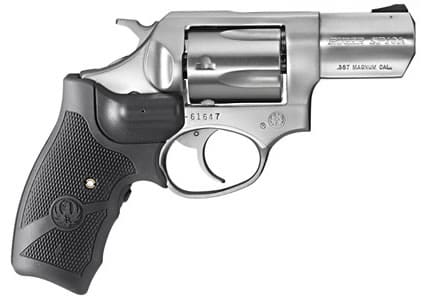We’ve already run a video wherein a criminal defense attorney presents an exhaustive and compelling case for not talking to the police before, during or after arrest. We’ll have another post on that later, with some fresh evidence on why it’s such a bad idea. Meanwhile, it’s also true that you should never let the police look around your home unless A) you need them to (e.g. to sweep your crib for bad guys) or B) they have a warrant. Once again, we turn to the legal eagles at leagle.com for a textbook example of why hospitality should have its limits . . .
The facts of the case CARDELLA v. STATE are, of course, disputed. This much is true: at some point on the evening in question, Dean Robert Cardella “asked” his tenant and former employee Kenneth Hicks to “get off my property” (or slightly slurred words to that effect).
For reasons of self-defense (claimed) or malice (charged), Mr. Cardella fired a .357 magnum revolver at or near Mr. Hicks. That’s the crucial distinction, apparently. The jury went with “at,” sending Mr Cardella to prison for “deadly conduct.”
From a legal standpoint, Mr. Cardella made two crucial mistakes. First, he didn’t call 911. When his tenant called the cops to report the incident, Cardella was already wrong-footed. The police assumed that Mr. Cardella was the aggressor and treated him as such.
Cardella missed his only real opportunity to control the “spin” related to the shooting. If he’d called the cops first and said, “I fired my weapon. I was attacked. My life was in danger”—AND NOTHING ELSE—he would have had a far better chance in court.
Not to mention the fact that the police didn’t search Mr. Hicks’ home, which might have contained illegal drugs or other damning items. Instead, sheriff’s deputy Carlos Reyes searched Mr. Cardella’s home. And here’s how that went down:
Reyes went to speak again with Cardella who had gone into his house. Reyes testified he asked Cardella if he owned a revolver, and Cardella answered that he did. Reyes asked to see the revolver and followed Cardella into the bedroom where the revolver was on the headboard of the bed. Reyes testified that he then retrieved the revolver. Reyes checked the revolver and saw that it was loaded with four rounds of .357 magnum jacketed hollow points and one round of a .38 caliber lead round nose. The handgun itself was a . 357 magnum, which holds five rounds. Reyes testified that as he handled the gun, he could smell an odor of freshly burnt gunpowder, which led him to believe that the gun had been fired recently. Reyes then secured the gun in his vehicle.
Cardella shouldn’t have said ANYTHING to the deputy. And he shouldn’t have allowed the police to come into his house to “look” at the gun. IF he was willing to surrender the weapon (judgement call on that one), Cardella should have gone into the house and retrieved it. While no further damning evidence resulted from the deputy’s entry, it’s probably only from a lack of observation.
For example, the incident involves alcohol. If Deputy Reyes had seen empty liquor bottles or beer cans from days previous, the prosecutor could have used that information to “prove” that Cardella was an habitual drunk.
More germane to TTAG’s readers (I hope), the Deputy could have seen other weapons, ammunition, holsters and TTAG on the computer screen (I hope). Prosecutors could have used that information to “prove” that Cardella was a gun nut.
[NOTE: This is why you should secure all your non-home defense guns in a closed and locked safe. Legally and practically, it’s best to do so in second, separate safe. If you open your only gun safe to gain access to a weapon in an emergency, you won’t lock it behind you.]
If (God forbid) there’s a shooting in your own home, you will have to allow police access to the crime scene. Otherwise, you will be arrested (something you should avoid if at all possible). BUT when the police ask “Do you mind if we look around?”, the answer is “Yes.”
Not a “YES I DO MIND (I’ve got a huge spliff on my bedside table).” More like, “I’d really prefer if you didn’t right now. We’re all a bit shocked.” And you will be. So you might not remember that bedside spliff, or the gun magazine by the toilet, or other items which you considered innocuous but a prosecutor will call “evidence.”
As for Cardella, he claimed there wasn’t enough evidence to convict him. Nobody found the bullet, so no one could tell if he’d aimed the gun at Hicks during his “accidental discharge.” The Texas Court of Appeals gave Cardella a bitch slapping.
Cardella makes a similar argument under his factual sufficiency complaint. He again argues that if Hicks’s version of the facts is true, then the bullet would have been found in Hicks’s residence or truck. Cardella further argues that the only credible evidence came from Cardella and not from Hicks. Viewing the evidence in a neutral light, however, we cannot say that the evidence supporting the verdict is so weak that the verdict is clearly wrong or manifestly unjust nor can we say that the evidence supporting the verdict is outweighed by the great weight and preponderance of the contrary evidence so as to render it clearly wrong and manifestly unjust. Thus, we hold the evidence factually sufficient to support the verdict. We overrule Cardella’s first issue on appeal.




